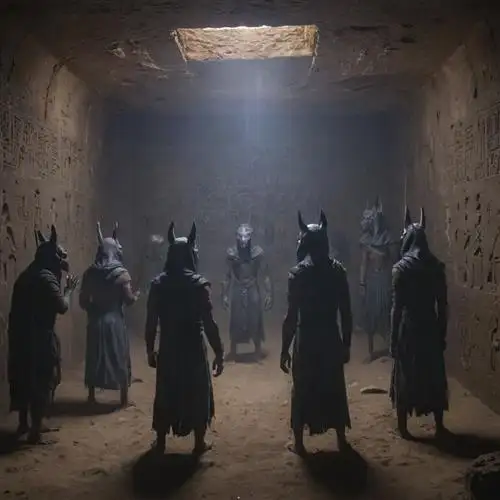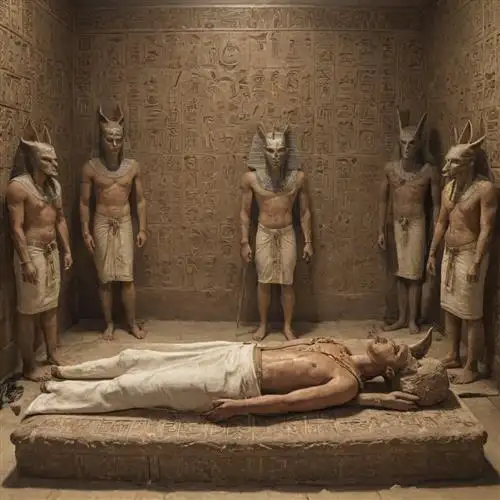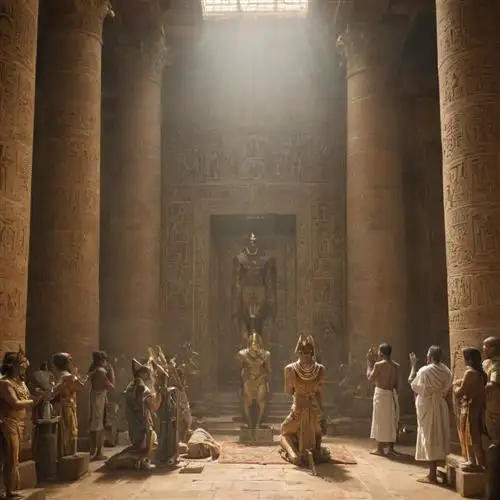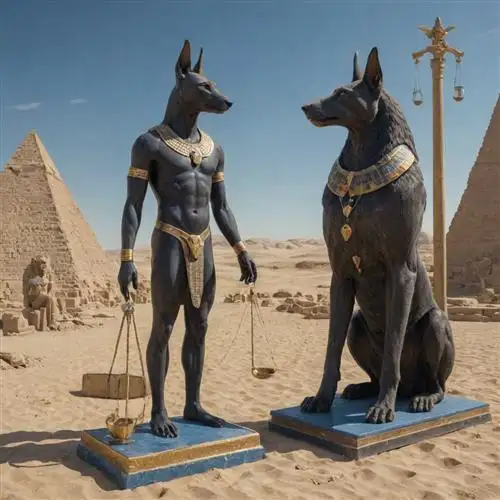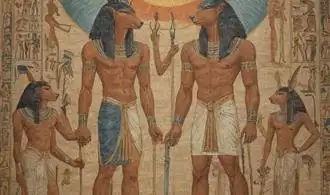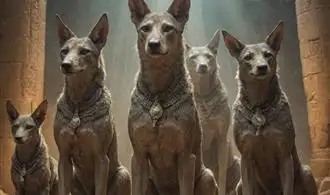
Anubis The Egyptian Jackal God
Anubis, the ancient Egyptian jackal god, has long been shrouded in mystery and intrigue. As one of the most prominent deities in the Egyptian pantheon, Anubis played a crucial role in the afterlife, guiding the deceased through the underworld and presiding over the process of mummification. To truly grasp the significance of this enigmatic figure, it is essential to delve into the rich symbolism and rituals associated with Anubis.
Anubis was depicted with the head of a jackal or a black dog, representing his role as the guardian of the dead. This canine-like appearance was not merely symbolic; it was believed to reflect Anubis' ability to navigate the liminal spaces between the living and the dead, acting as a bridge between the mortal world and the realm of the afterlife.
The black color of Anubis' skin was also highly significant, as it was associated with the fertile and regenerative properties of the Nile River. This connection to the cycle of life and death further solidified Anubis' status as a deity of great power and importance in the Egyptian spiritual landscape.
One of the most crucial rituals associated with Anubis was the process of mummification. As the god responsible for embalming and preserving the dead, Anubis oversaw the intricate process of preparing the body for the afterlife. This included the removal of the internal organs, the drying of the body, and the wrapping of the mummy in linen bandages. These rituals were believed to ensure the safe passage of the deceased into the next life, with Anubis guiding the soul through the perils of the underworld.
In addition to his role in mummification, Anubis was also closely linked to the weighing of the heart ceremony, a crucial step in the journey to the afterlife. During this ritual, the deceased's heart was weighed against the feather of Ma'at, the goddess of truth and justice. If the heart was found to be pure and free from sin, the individual was granted access to the afterlife. Anubis was responsible for presiding over this sacred ceremony, ensuring the fairness and accuracy of the process.
The Secrets of Anubis Rituals
Anubis, the ancient Egyptian god of the dead, has long been the subject of fascination and mystery. His rituals, shrouded in secrecy, have captivated the imaginations of scholars and enthusiasts alike. In this article, we will delve into the heart of Anubis' rituals, uncovering the hidden truths that few have dared to uncover.
At the core of Anubis' rituals lies the concept of the afterlife. The ancient Egyptians believed that Anubis, the jackal-headed deity, was responsible for guiding the souls of the deceased through the treacherous journey to the afterlife. This journey was marked by a series of intricate rituals, each with its own significance and symbolic meaning.
One of the most crucial aspects of Anubis' rituals was the process of mummification. The ancient Egyptians believed that the preservation of the physical body was essential for the soul's safe passage to the afterlife. The mummification process, overseen by Anubis, involved a meticulous series of steps, including the removal of internal organs, the application of various embalming materials, and the wrapping of the body in linen bandages.
Another key ritual associated with Anubis was the weighing of the heart. This ceremony, known as the "Weighing of the Heart," was a crucial step in the journey to the afterlife. During this ritual, the deceased's heart was weighed against the feather of truth, representing the person's moral and ethical conduct during their lifetime. If the heart was found to be pure, the individual was granted access to the afterlife; if it was deemed too heavy, they were condemned to a fate worse than death.
The rituals surrounding Anubis also involved the use of specific symbols and artifacts. The jackal, Anubis' sacred animal, played a central role in many of these rituals, representing the deity's connection to the underworld and the cycle of life and death. Additionally, the ankh, the ancient Egyptian symbol of life, was often incorporated into Anubis' rituals, symbolizing the immortality of the soul.
Perhaps one of the most intriguing aspects of Anubis' rituals is the role of the priests who conducted them. These individuals were believed to possess a deep understanding of the afterlife and the mysteries of the divine. They were responsible for overseeing the various rituals and ceremonies associated with Anubis, ensuring that the deceased were properly prepared for their journey to the afterlife.
Mummification and the Role of Anubis
Anubis, the jackal-headed god of the ancient Egyptian pantheon, played a central role in the mummification process, a ritual essential to the afterlife beliefs of the ancient Egyptians. As the guardian of the dead and the embalming process, Anubis oversaw the intricate steps involved in preserving the physical body, ensuring the deceased's successful transition to the next world.
The mummification process was a complex and meticulous undertaking, often taking up to 70 days to complete. Anubis was responsible for guiding the embalmers through each phase, from the initial cleansing and removal of the internal organs to the final wrapping and adornment of the body. The jackal-headed god was believed to have the power to reanimate the deceased, transforming the mortal remains into a vessel capable of sustaining the soul in the afterlife.
Anubis' role was not limited to the physical aspects of mummification. He was also responsible for weighing the heart of the deceased against the feather of Ma'at, the goddess of truth and justice, during the final judgment in the afterlife. This ritual, known as the "Weighing of the Heart," determined whether the individual's soul would be allowed to pass into the afterlife or be consumed by the devouring goddess Ammit.
The presence of Anubis was often depicted in the tombs and funerary rituals of the ancient Egyptians. Statues and reliefs of the jackal-headed god were placed alongside the mummy, ensuring his watchful gaze over the deceased during the transition to the afterlife. Additionally, the color black, associated with Anubis, was prevalent in the mummification process, symbolizing the regenerative and protective powers of the god.
Devotional Practices and Offerings to Anubis
Anubis, the jackal-headed deity of ancient Egyptian mythology, has long been revered for his role as the guardian of the dead and the protector of the afterlife. For those seeking to connect with this powerful deity, a variety of devotional practices and offerings have been observed throughout history. Delve into the intricate world of Anubis rituals and uncover the secrets that the experts may not want you to know.
One of the most fundamental devotional practices associated with Anubis is the offering of mummification-related items. As the god responsible for the embalming process, Anubis is often honored with symbolic offerings such as natron (a salt used in the mummification process), linen bandages, and myrrh (a fragrant resin used in the embalming process). These items can be placed upon an altar or in a sacred space dedicated to Anubis, as a way of acknowledging his importance in the journey to the afterlife.
Another common practice is the offering of food and drink. Anubis was believed to guide the deceased through the afterlife, and providing sustenance for this journey was seen as an important act of devotion. Traditional offerings may include bread, beer, and various fruits and vegetables. Practitioners often take the time to prepare these offerings with care, imbuing them with prayers and intentions for the deity.
Rituals involving the creation of small statues or figurines of Anubis are also prevalent in many Anubis-focused spiritual traditions. These statues can be used as a focal point for meditation, prayer, or as part of a larger ritual. Some practitioners may even create personalized Anubis figures, infusing them with their own energy and intentions.
In addition to material offerings, Anubis devotees often engage in symbolic acts of purification and transformation. This may involve rituals such as cleansing with water, burning incense, or performing specific gestures or chants. These practices are believed to align the practitioner with the energy and essence of Anubis, facilitating a deeper connection and understanding of the deity.
Anubis in the Afterlife and the Weighing of the Heart
Anubis, the jackal-headed Egyptian deity, played a pivotal role in the afterlife rituals of ancient Egypt. As the god of embalming and the protector of the dead, Anubis was responsible for guiding the deceased through the intricate process of the Weighing of the Heart, a crucial step in the journey to the afterlife.
In the Weighing of the Heart ceremony, the deceased's heart was placed on one side of a scale, while the feather of Maat, the goddess of truth and justice, was placed on the other. This symbolized the examination of the individual's moral and ethical conduct during their lifetime. If the heart balanced perfectly with the feather, it was deemed pure, and the deceased was allowed to proceed to the next stage of the afterlife. However, if the heart was found to be heavier, it was devoured by the devouring demon, Ammit, effectively condemning the soul to eternal damnation.
Anubis played a vital role in this process, serving as the overseer and protector of the ritual. He would carefully observe the weighing, ensuring the accuracy and fairness of the judgment. Additionally, Anubis would provide guidance and support to the deceased, assisting them in navigating the treacherous path to the afterlife.
In some depictions, Anubis is shown standing beside the scale, holding the deceased's hand and guiding them through the process. This symbolizes the deity's compassion and commitment to ensuring the successful transition of the soul to the afterlife. The jackal-headed god was also responsible for mummifying the deceased, a critical step in preserving the body and preparing it for the journey to the afterworld.


